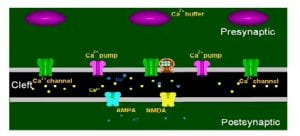EONS v1 is the perfect tool to study the basic interactions between synaptic elements in a friendly manner. There are no complicated equations to write: all the models are predefined! This version is a great tool for first time users and students interested in learning about synapses, as well as for studying geometry and distribution hypotheses in a 2D rectangular geometry.
From a computational standpoint, EONS is currently a windows only application.
See EONS v1 in action: visual feedback during a EONS v1 simulation with an initial presynaptic paired-pulse depolarization – Calcium enters in the presynaptic terminal and triggers glutamate release.
Structure of EONS v1.*
EONS consists in a graphical modeling platform in which elements that comprise a single glutamatergic synapse (both pre- and post-synaptically) as well as the underlying synaptic geometry can be modified.
This animation describes the main mechanisms involved during glutamatergic synaptic tranmission occuring after initial presynaptic depolarization.
Presynaptic elements
- Calcium channels (N, L, T types)
- Localized calcium buffers
- Diffuse calcium buffers
- Calcium diffusion modeling
- Calcium pumps
- vesicular kinetics
Synaptic cleft
In the synaptic cleft, a uniform diffusion of neurotransmitter is modeled (we focus our attention to the area close the the release site).
Postsynaptic elements
- AMPA receptors
- NMDA receptors
- Metabotropic glutamate receptors
- Endoplasmic Reticulum (ER)
- ER calcium ATPase
- ER IP3 receptors
- Simulated excitatory postsynaptic potential
We are currently in the process of adding several elements to the postsynaptic density:
- Slow and medium potassium channels
- Calcium channels
- Sodium/calcium exchanger
- Long Term Potentiation (LTP)
For more information, consult the user guide.
Latest Posts About EONS
- New Version of EONS v1.2New Version of EONS v1.2. Significant speed improvements, batch simulations, etc… (see history for release notes) (Windows version only )…Continue Reading New Version of EONS v1.2
- EONS V1.1.3 Release 362Bugs Fixes: None. Models modifications: Internals: All models are generated using SBML and incorporated in EONS New numerical methods significantly decrease computation time (Heun-Euler, RKF and BDF2TRAP variable step methods) Simplified presynaptic calcium diffusion available Neurotransmitter diffusion based on Savtchenko paper (faster than 2D convolution) Code cleanup: A lot of cleanup in the main interface…Continue Reading EONS V1.1.3 Release 362
- New Version of EONS v1.1.3New Version of EONS < a href="http://128.125.37.80:8080/login.html">v1.1.3. Significant speed improvements, GABA feed-forward, etc… (see history for release notes)…Continue Reading New Version of EONS v1.1.3

